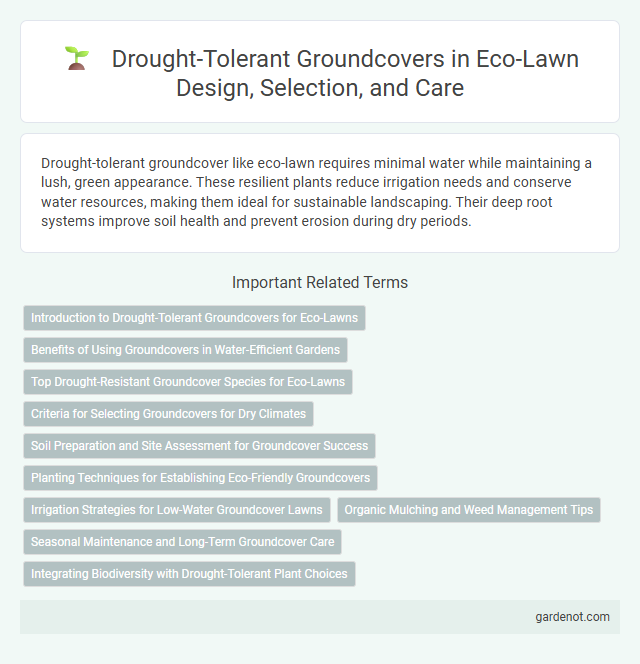Drought-tolerant groundcover like eco-lawn requires minimal water while maintaining a lush, green appearance. These resilient plants reduce irrigation needs and conserve water resources, making them ideal for sustainable landscaping. Their deep root systems improve soil health and prevent erosion during dry periods.
Introduction to Drought-Tolerant Groundcovers for Eco-Lawns
Drought-tolerant groundcovers for eco-lawns offer sustainable alternatives to traditional turfgrass by requiring minimal water and maintenance. These plants, such as creeping thyme, sedum, and native grasses, thrive in dry conditions while preventing soil erosion and promoting biodiversity. Incorporating drought-resistant species reduces irrigation needs, conserves water resources, and supports eco-friendly landscaping practices.
Benefits of Using Groundcovers in Water-Efficient Gardens
Drought-tolerant groundcovers like creeping thyme and blue star creeper reduce water usage by significantly lowering evaporation rates compared to traditional lawns, making them ideal for water-efficient gardens. These low-maintenance plants stabilize soil, prevent erosion, and suppress weeds, which reduces the need for chemical herbicides and conserves resources. Their deep root systems improve soil health and support ecosystem biodiversity while maintaining an attractive, resilient landscape in arid climates.
Top Drought-Resistant Groundcover Species for Eco-Lawns
Top drought-resistant groundcover species for eco-lawns include creeping thyme, buffalo grass, and sedum, all known for their low water requirements and ability to thrive in arid conditions. Creeping thyme offers fragrant foliage and vibrant blooms, while buffalo grass provides a durable, dense green carpet that conserves moisture. Sedum, a succulent groundcover, stores water in its leaves, making it highly efficient for sustainable, eco-friendly lawn alternatives.
Criteria for Selecting Groundcovers for Dry Climates
Drought-tolerant groundcovers for dry climates must exhibit deep root systems to efficiently access scarce water sources and withstand prolonged periods of drought stress. Selection criteria emphasize low water requirements, heat resistance, soil adaptability, and minimal maintenance needs to ensure sustainable coverage and soil erosion prevention. Species such as creeping thyme, sedum, and buffalo grass demonstrate optimal performance in arid environments by maintaining green cover with limited irrigation.
Soil Preparation and Site Assessment for Groundcover Success
Thorough soil preparation is essential for drought-tolerant groundcover success, involving soil testing to assess pH levels, nutrient content, and drainage capacity. Proper site assessment identifies sun exposure, soil texture, and moisture retention, allowing selection of groundcovers suited to local conditions. Enhancing soil with organic matter improves structure and water-holding ability, crucial for establishing resilient eco-lawns in arid environments.
Planting Techniques for Establishing Eco-Friendly Groundcovers
Drought-tolerant groundcovers such as sedum, creeping thyme, and buffalo grass thrive when planted using well-prepared, aerated soil to promote deep root growth and moisture retention. Applying mulch around new plants helps conserve soil moisture and suppress weeds, crucial for eco-friendly, water-efficient lawn alternatives. Utilizing drip irrigation during the establishment phase ensures targeted watering, reducing evaporation and supporting sustainable landscaping practices.
Irrigation Strategies for Low-Water Groundcover Lawns
Drought-tolerant groundcover lawns require irrigation strategies that maximize water efficiency while maintaining plant health, such as drip irrigation systems and deep, infrequent watering schedules to promote deep root growth. Selecting native or adapted species like creeping thyme, sedum, or buffalo grass reduces water demand and enhances drought resilience. Mulching around groundcovers further conserves soil moisture and regulates temperature, optimizing irrigation performance for low-water landscapes.
Organic Mulching and Weed Management Tips
Drought-tolerant groundcovers thrive with organic mulching that retains soil moisture and suppresses weed growth, enhancing soil health and reducing water needs. Applying a 2-3 inch layer of organic mulch, such as shredded bark or compost, helps maintain consistent moisture levels and prevents weed seeds from germinating. Regularly monitoring and manually removing invasive weeds supports the groundcover's resilience while minimizing the use of chemical herbicides.
Seasonal Maintenance and Long-Term Groundcover Care
Drought-tolerant groundcovers require minimal watering, especially during dry seasons, significantly reducing water consumption and maintaining lush greenery. Seasonal maintenance involves regular weeding, occasional trimming, and monitoring for pests to ensure healthy growth and prevent invasive species from spreading. Long-term care includes soil aeration, mulching to retain moisture, and periodic replanting of bare spots to sustain groundcover density and resilience against harsh weather conditions.
Integrating Biodiversity with Drought-Tolerant Plant Choices
Drought-tolerant groundcovers like creeping thyme, sedum, and native grasses enhance eco-lawns by conserving water while supporting local biodiversity. These plants reduce irrigation needs and create habitats for pollinators, beneficial insects, and soil microorganisms. Incorporating a diverse mix of drought-resistant species improves ecosystem resilience and sustains soil health under dry conditions.
Drought-tolerant groundcover Infographic

 gardenot.com
gardenot.com